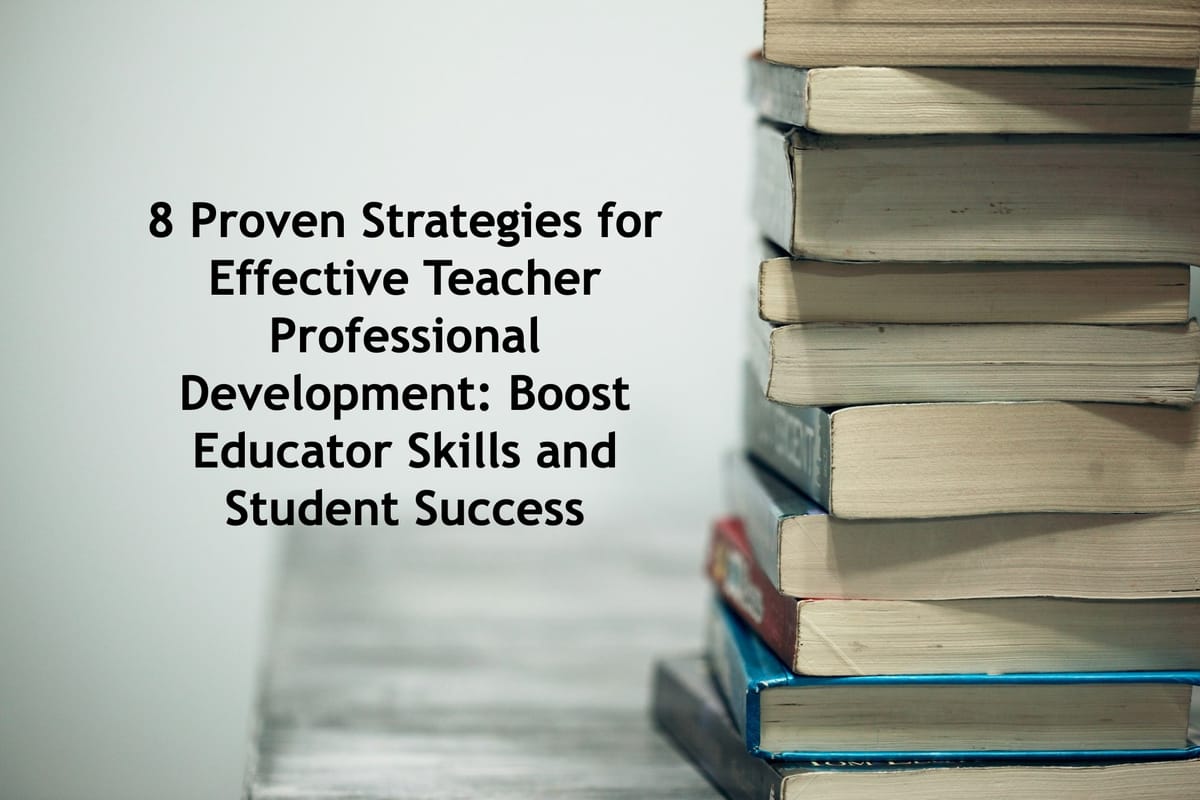8 Proven Strategies for Effective Teacher Professional Development: Boost Educator Skills and Student Success
Let's explore some key principles for designing effective professional development that genuinely benefits educators and, by extension, their students.

Professional development is a crucial aspect of a teacher's career, serving as a cornerstone for continuous improvement and adaptation to evolving educational landscapes. However, not all training sessions are created equal.
Let's explore some key principles for designing effective professional development that genuinely benefits educators and, by extension, their students.
The most important thing to remember is that teachers need relevant professional development sessions. They are busy, and their time must be respected.
1. Tap into Teachers' Strengths
Effective professional development should allow teachers to leverage their existing skills and knowledge. This approach boosts confidence and promotes a culture of peer learning and collaboration.
Example: Imagine a high school with a diverse faculty. Instead of bringing in external experts for every session, the school could implement a "Teacher Expertise Showcase" series. In this program, teachers with particular strengths or innovative practices could lead workshops for their colleagues. For instance:
- A history teacher known for engaging storytelling techniques could lead a session on "Bringing History to Life in the Classroom."
- A science teacher who excels at designing hands-on experiments could conduct a workshop on "Creating Budget-Friendly Lab Experiences."
- An English teacher knowledgeable about integrating technology could guide peers through "Digital Tools for Enhancing Literary Analysis."
This approach utilizes in-house expertise and empowers teachers as leaders and innovators within their professional community.
2. Mirror Engaging Student Learning Approaches
Professional development can and should be modeled after the same engaging methods used with students. This makes the sessions more enjoyable for teachers and allows them to experience these methods from a learner's perspective, enhancing their understanding and implementation.
Let's explore each approach in more detail:
Project-based learning:
Teachers could collaborate on creating interdisciplinary units. For example, a group of middle school teachers from different subject areas could design a quarter-long project on "Sustainable Cities." This project would integrate elements of science (environmental impact), math (data analysis and statistics), social studies (urban planning and policy), and language arts (proposal writing and presentations).
Personalized learning:
Offer a choice of workshops based on individual needs and interests. A school district could set up a "Professional Development Marketplace" where teachers can choose from various sessions, each addressing different skills or topics. Teachers could create their own "learning pathway" by selecting sessions that align with their professional goals and classroom needs.
Play-based learning:
Use educational games or simulations to explore new teaching strategies. For instance, teachers could participate in a "Classroom Management Escape Room" where they solve puzzles related to various classroom scenarios, learning and discussing strategies as they progress through the game.
Inquiry-based learning:
Encourage teachers to investigate and solve real classroom challenges. Set up "Action Research Groups" where teachers identify a common issue (e.g., increasing student engagement in online learning), research potential solutions, implement them in their classrooms, and then reconvene to share results and insights.
3. Ensure Relevance
The topics covered should be directly applicable to the attending teachers. This principle is crucial for maintaining engagement and ensuring professional development translates into improved classroom practices.
To achieve this:
- Conduct regular needs assessments: Use surveys, focus groups, or analysis of student performance data to identify areas where teachers need support.
- Differentiate sessions: Offer concurrent sessions tailored to grade levels, subject areas, or experience levels.
- Connect to school/district goals: Align professional development with broader educational objectives to create a coherent improvement strategy.
Example: A K-12 school district could organize a professional development day with different tracks:
- Elementary track: Focus on early literacy strategies and play-based learning
- Middle school track: Address adolescent social-emotional needs and cross-curricular project design
- High school track: Explore college and career readiness initiatives and advanced technology integration
- Particular education track: Discuss the latest research in differentiation and assistive technologies
This approach ensures that each teacher receives training directly relevant to their daily work.
4. Balance Activity and Information
Incorporating active components avoids the "sit and get" model. This approach respects teachers as adult learners and professionals capable of constructing their understanding and applying concepts in context.
Here's an expanded example of how this might look in practice:
Topic: Formative Assessment Strategies
- Brief presentation (20 minutes): Introduction to fundamental principles and a variety of formative assessment techniques
- Hands-on activity (30 minutes): Teachers split into subject-area groups to adapt these techniques to their specific contexts
- Role-play (20 minutes): Teachers take turns being "students" while colleagues practice implementing the strategies
- Reflection and planning (20 minutes): Individual time for teachers to plan how they'll implement these strategies in upcoming lessons
- Sharing and discussion (30 minutes): Teachers present their plans to a partner or small group for feedback and ideas
This format balances receiving new information and actively engaging with the content.
5. Address Real Challenges
Professional development should help teachers tackle daily issues, ultimately improving student outcomes. This approach ensures the training is immediately applicable and motivates teachers to implement their learning.
Implementation strategy:
- Regular surveys: Conduct quarterly online surveys asking teachers to identify their most pressing classroom challenges.
- Data analysis: Review student performance data to identify areas needing improvement.
- Observation feedback: Use insights from classroom observations to inform professional development topics.
- Teacher-led problem-solving: Form "Challenge Teams" where teachers work together to address common issues.
Example: If data shows that English Language Learners (ELLs) struggle across subject areas, the school could organize workshops on "Supporting ELLs Across the Curriculum." This might include:
- Session 1: Understanding second language acquisition and its impact on learning
- Session 2: Strategies for making content accessible to ELLs in different subjects
- Session 3: Collaborative planning time for teachers to modify upcoming units to better support ELLs
- Session 4: Sharing and critiquing implemented strategies, discussing outcomes and next steps
6. Keep It Focused
Concentrate on a few key areas rather than trying to cover too much ground. This allows for deeper exploration and better retention, leading to more meaningful changes in teaching practice.
Example of a year-long professional development plan with three main themes:
1. Technology Integration
- Fall: Introduction to critical tools and platforms
- Winter: Subject-specific applications and lesson planning
- Spring: Showcasing successful implementation and problem-solving
2. Social-emotional learning (SEL)
- Fall: Understanding SEL principles and their importance
- Winter: Strategies for integrating SEL into academic subjects
- Spring: Assessing SEL growth and planning for the next year
3. Formative Assessment
- Fall: Overview of formative assessment strategies
- Winter: Using formative assessment data to guide instruction
- Spring: Peer observation and feedback on formative assessment practices
By focusing on these three areas throughout the year, teachers have the opportunity to deeply engage with each topic, experiment with new strategies, and refine their practice over time.
7. Provide Ongoing Support
Avoid one-off sessions by planning for follow-up and continued exploration of topics. This approach recognizes that meaningful change in teaching practice takes time and ongoing support.
Strategies for ongoing support:
- Professional Learning Communities (PLCs): Form subject-area or grade-level PLCs that meet regularly to discuss the implementation of new strategies, share successes and challenges, and collaboratively problem-solve.
- Peer Observation Program: Set up a system where teachers can observe colleagues implementing new techniques and provide constructive feedback.
- Digital Resource Hub: Create an online platform where teachers can access workshop materials, share resources, and engage in ongoing discussions.
- Coaching: Provide individual or small-group coaching sessions to support teachers in implementing new strategies.
- Follow-up Workshops: Schedule "deep dive" sessions that build upon previous workshops and allow for more advanced exploration of topics.
Example: After a workshop on project-based learning (PBL), ongoing support might include:
- Monthly PLC meetings focused on PBL implementation
- A "PBL Showcase" where teachers present their projects and student outcomes
- Individual coaching for teachers struggling with aspects of PBL
- A dedicated section in the school's digital resource hub for PBL materials and discussion forums
8. Include a Call to Action
End each session with clear, actionable steps for teachers to implement learning. This approach bridges the gap between professional development and classroom practice, increasing the likelihood that new strategies will be applied.
Example: After a workshop on differentiation strategies, teachers could be given the following call to action:
- Immediate (Next class): Implement a straightforward differentiation strategy, such as providing two different versions of an assignment.
- Short-term (Within a week): Plan and execute a fully differentiated lesson, considering content, process, and product.
- Medium-term (Within a month): Design a unit with differentiation throughout, including pre-assessment, tiered activities, and varied assessment options.
- Long-term (Ongoing): Keep a "Differentiation Journal" to record strategies used, student responses, and ideas for future implementation. Share insights at the next PLC meeting.
By incorporating these elements and providing detailed, practical examples, we can create professional development experiences that are engaging, relevant, and genuinely beneficial for educators. Remember, the goal is to respect teachers' time and expertise while providing them with valuable tools and strategies to enhance their practice and, ultimately, student learning. Effective professional development is an investment in our teachers and, by extension, in the future of our students and our education system.
Sources and Resources
- Effective Teacher Professional Development
- Designing Professional Development That Works
- The Six Flaws of “Traditional” Professional Development
- Prioritizing Teachers' Growth and Passions: Creating a Sustainable and Engaged Teaching Team
- How to implement effective professional development for teachers
❤ Enjoy this Article?
🍵 Show Your Support and 🤗 Share It



